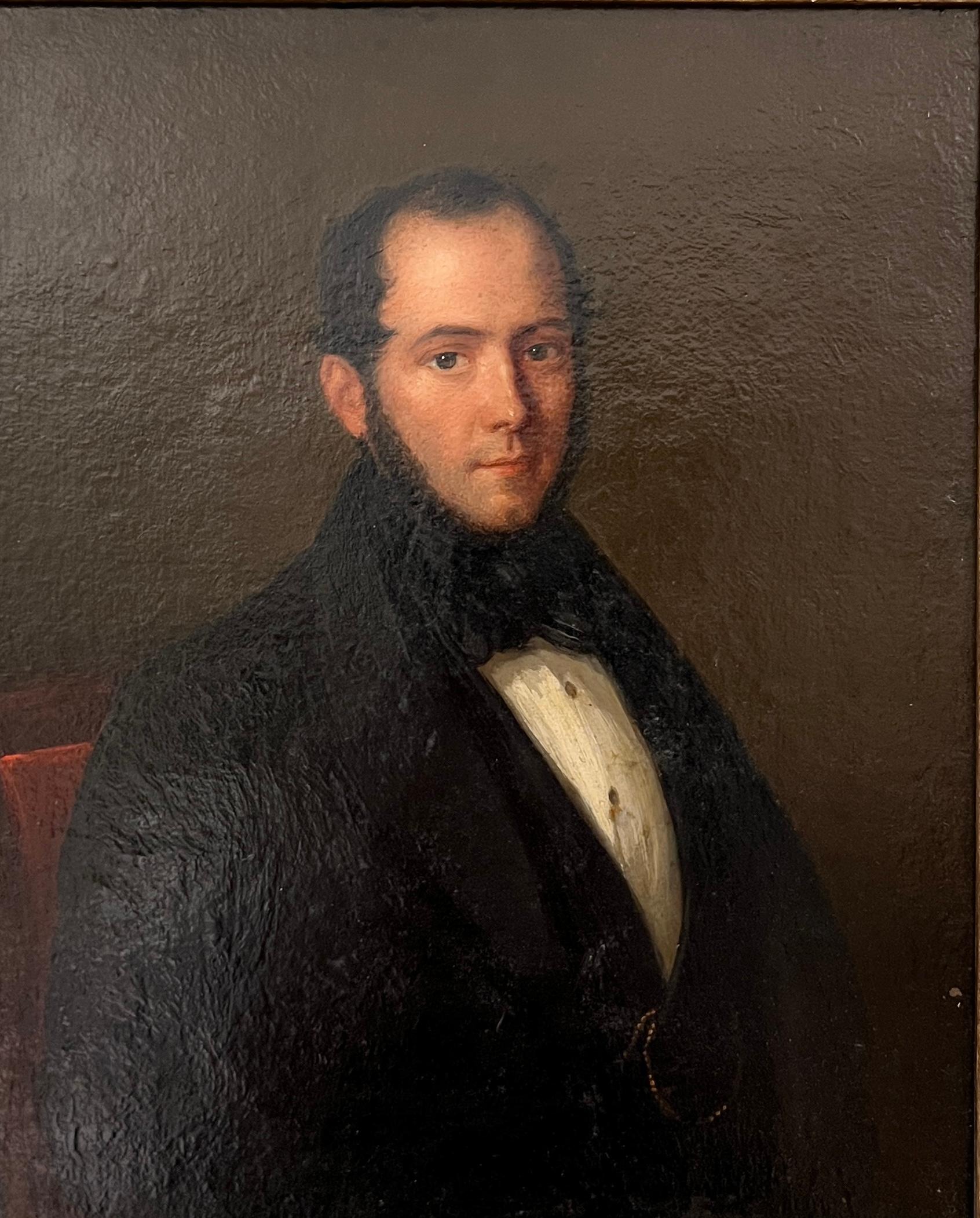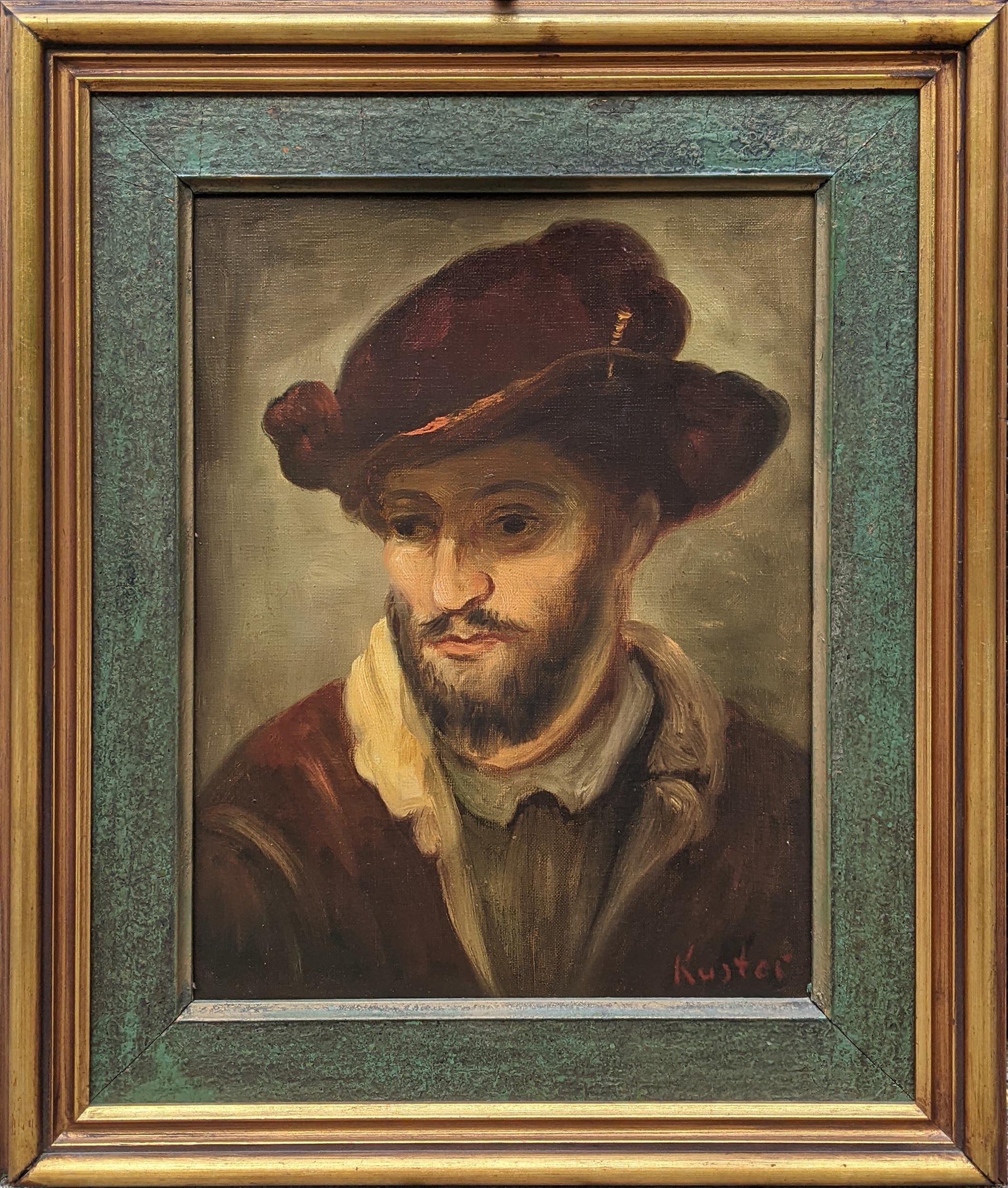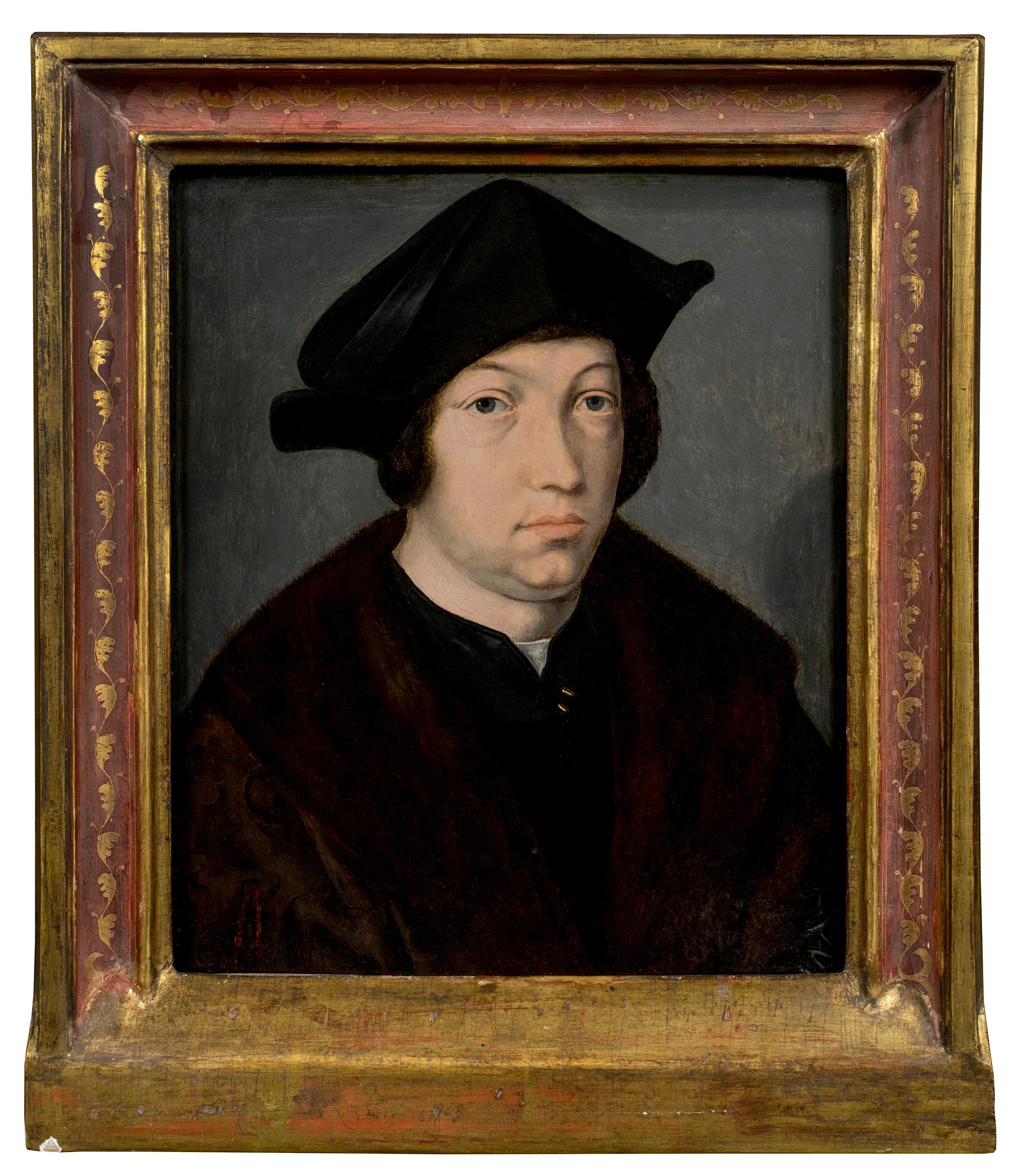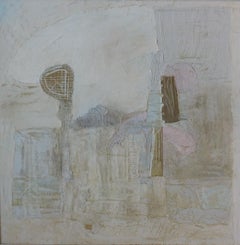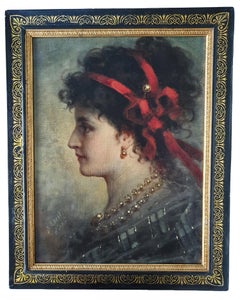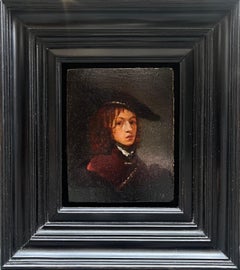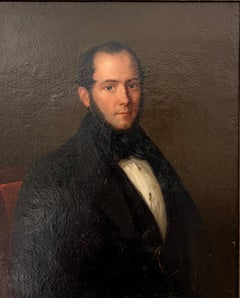Items Similar to Portrait of a well-to-do gentleman
Want more images or videos?
Request additional images or videos from the seller
1 of 15
Portrait of a well-to-do gentleman
$3,590.11
£2,666.85
€3,000
CA$4,952.81
A$5,444.50
CHF 2,861.38
MX$66,116.01
NOK 35,694.96
SEK 33,818.47
DKK 22,837.55
About the Item
Portrait of a well-to-do gentleman in pastel on parchment.
Signed left: Marteau L. 1760.
French School, possibly by Louis Marteau (1715 – 1804)
In a gilded 19th century frame.
Dimensions without frame: 55 x 43 cm.
With frame: 78.5 x 68,5 cm.
Condition: In fair condition.
Ludwik Marteau, originally Louis-François Marteau (c.1715 - 2 November 1804) was a Polish court painter who served under kings Augustus III and Stanisław August Poniatowski. All of his known works are portraits; both full size and miniatures.
Born in Paris, his father was a carpenter at the royal Palace of Versailles. One of his aunts on his mother's side was married to the Polish court painter, Louis de Silvestre. It is not known exactly when he arrived in Poland, but it appears that his teacher, Maurice Quentin de La Tour made the recommendation to go and Silvestre arranged for his position there.
In 1752, on the way, he spent some time at the court of Jan Klemens Branicki in Białystok, where he painted portraits of the hetman's family. Once in Warsaw, King August III gave him the position of court painter. Initially, he lived at one of Branicki's manors then, from 1768 to 1780, he lived near the Royal Castle.
From 1780-1783, he gave lessons to Anna Rajecka, a favorite of King Stanisław August Poniatowski, who was meant to become a court painter, but spent most of her life in Paris. Later, her husband, Pierre-Marie Gault de Saint-Germain, would give Marteau a prominent place in his history of French painting.
According to the art historian, Edward Rastawiecki, Marteau was a bit of a fop and always dressed in French style, even sporting short pants and white stockings in the middle of winter, and refusing to attend the fanciest affair if there was too much mud or snow on the streets.
From 1765 to 1795, he is shown on Royal Records as "The King's Painter". He received a fixed salary as well as payments for each individual work. An art academy project that would have made him a professor at the annual rate of 300 ducats never materialized. He was given a monopoly on painting portraits of the guests that attended the King's famous Thursday Dinners.[1] After the death of Stanisław August, he came under the protection of Princess Izabela Lubomirska, the King's cousin and a favorite, whose father had forbidden her to marry the King when she was a girl.
In many instances, attribution is difficult to ascertain, as Marteau did not sign his paintings. Even so, his catalogued portraits constitute a who's-who of notable 18th century Poles, including Stanisław Konarski, Adam Naruszewicz, Ignacy Krasicki, Joachim Chreptowicz, Celestyn Czaplic, Michał Jerzy Mniszech, Ignacy Potocki, Andrzej Mokronowski, Stanisław Poniatowski, Stanisław Trembecki, Andrzej Hieronim Zamoyski, Grzegorz Piramowicz, Franciszek Bohomolec and (one of his best-known) Hugo Kołłątaj. In 1831, following the November Uprising, most of his portraits were transported to Saint Petersburg by order of Tsar Nicholas I. Three years later, they were burned in an effort to destroy significant records of Polish culture.
- Attributed to:Louis Marteau (1715 - 1804, French)
- Dimensions:Height: 21.66 in (55 cm)Width: 16.93 in (43 cm)
- Medium:
- Period:
- Condition:
- Gallery Location:DEVENTER, NL
- Reference Number:1stDibs: LU2366212033872
About the Seller
5.0
Vetted Professional Seller
Every seller passes strict standards for authenticity and reliability
Established in 2015
1stDibs seller since 2023
9 sales on 1stDibs
Typical response time: 1 hour
- ShippingRetrieving quote...Shipping from: DEVENTER, Netherlands
- Return Policy
Authenticity Guarantee
In the unlikely event there’s an issue with an item’s authenticity, contact us within 1 year for a full refund. DetailsMoney-Back Guarantee
If your item is not as described, is damaged in transit, or does not arrive, contact us within 7 days for a full refund. Details24-Hour Cancellation
You have a 24-hour grace period in which to reconsider your purchase, with no questions asked.Vetted Professional Sellers
Our world-class sellers must adhere to strict standards for service and quality, maintaining the integrity of our listings.Price-Match Guarantee
If you find that a seller listed the same item for a lower price elsewhere, we’ll match it.Trusted Global Delivery
Our best-in-class carrier network provides specialized shipping options worldwide, including custom delivery.More From This Seller
View AllAntique oil paining, A laughing man with an upturned glass, Dutch golden age
Located in DEVENTER, NL
Anonymous, 18th century
Inspired by a painting by Petrus Staverenus (1610/1612 – 1654-07-28/1664-07-28) from a series of Five Senses
'Taste: A laughing man...
Category
18th Century Old Masters Portrait Paintings
Materials
Canvas, Oil
Abstract composition
Located in DEVENTER, NL
Paolo Sistilli (1950)
Abstract composition
Signed lower right corner Sistilli and dated 87
Mixed media
104 x 105 cm.
In wooden frame
Paolo Sistil...
Category
1980s Abstract Abstract Paintings
Materials
Mixed Media
Decorative river landscape in romantic style, oil on canvas
Located in DEVENTER, NL
Decorative river landscape in romantic style,
Signed lower left 'I Roy', unknown artist,
Oil on canvas
Dimensions excl. frame: 49 x 65
Dimensions incl. frame: 64 x 80 x 7 cm.
In go...
Category
20th Century Romantic Landscape Paintings
Materials
Canvas, Oil
Portrait of a Circassian courtisane, in original 19th century frame, orientalist
Located in DEVENTER, NL
Anton Ebert (1845-1896)
A celebrated painter born in a noble familie in castle kladrau in mies, bavaria. His father was royal
treasurer. He studied in Prag...
Category
19th Century Portrait Paintings
Materials
Canvas, Oil
Madonna and child, Italian school, 18th century
Located in DEVENTER, NL
Italian School, 18th century
Depicted are the Madonna and Child Jesus, the virgin Mary is holding the Child Jesus lovingly in her arms. The child, lying on a bundle of cloth and with...
Category
18th Century Figurative Paintings
Materials
Canvas, Oil
Pair of Romantic landscape paintings (pendant), oil on panel, in gilt wood frame
Located in DEVENTER, NL
Pair of Romantic landscape paintings (pendant) with figures, Inspired by 17th century Dutch landscape painting
Oil on panel
In g...
Category
Mid-19th Century Romantic Landscape Paintings
Materials
Oil, Wood Panel
You May Also Like
Portrait of a man
By Antoine Jean Gros
Located in Paris, IDF
French school from the beginning of the 19th century
Three-quarter bust portrait of a man
Oil on panel
28 x 21 cm
Circa 1820
This portrait of a man, typical of the French school o...
Category
Early 19th Century French School Portrait Paintings
Materials
Oil
Portrait of a Young Man
By (After) Rembrandt van Rijn
Located in London, GB
Pupil of Rembrandt
Portrait of a Young Man
17th Century
Oil on oak panel
Image size: 4 1/4 x 5 inches (11 x 13 cm)
Dutch ebonised frame
This small portrait is of a young man, staring inquisitively out towards the viewer. The realism of his appearance is striking, with great care taken in the depiction of the man’s features - for example, his full lips and the slight bump in the bridge of his nose. The man wears a rich burgundy doublet and a black cap and is adorned with gold accessories, indicating a degree of wealth - it is likely that this is a miniature portrait for a wealthy patron. The warm flesh tones of this painting and the intricate rendering of the man’s curly brown hair demonstrate the artistry of the painter, who has successfully captured the image of youth within his brushstrokes.
Rembrandt’s Pupils
Upon completing his artistic education, Rembrandt opened a studio and began to take students - the first of which were Gerrit Dou and Isaac Jouderville. The studio functioned as an art school, in which materials and guidance were provided - contrary to the studios of his peers, Rembrandt did not offer lodging to his pupils. The families of prospective pupils had to pay Rembrandt 100 guilders (enough for a house at the time) for this artistic education, and the profits from any works produced by pupils under Rembrandt would be paid to the master rather than kept by the student-artist - this contributed substantially to the master’s income.When taking on pupils, Rembrandt looked for those who could already paint, and guided their styles to reflect his. By choosing pupils who were somewhat experienced artists, Rembrandt had an array of painters that could be involved at any stage of assisting with the creation of his works - in this way, Rembrandt’s pupils often functioned as studio assistants as well. In order to perfect Rembrandt’s style, pupils would paint copies of their teacher’s works, sometimes adding their own distinct variations. They would use the same subjects and models as Rembrandt himself, and would accompany him on outdoor trips to paint nature and landscapes. The extensive copying and utilisation of same source materials has rendered Rembrandt’s work and the work of his pupils difficult to differentiate, even in the modern era.At least 50 pupils were taught by Rembrandt, with many continuing on to become his studio assistants. A few graduated into successful artists in their own right - for example, Govaert Flinck...
Category
17th Century Portrait Paintings
Materials
Oak, Oil, Panel
A Portrait of a Gentleman, thought to be Moses Diego Lopez Pereira
Located in London, GB
Austrian School, 18th Century
A Portrait of a Gentleman, thought to be Moses Diego Lopez Pereira, 1st Baron d’Aguilar, in an elaborate coat and a powdered wig
Oil on canvas
Provena...
Category
18th Century Paintings
Materials
Canvas, Oil
Portrait of an elegant
Located in Genève, GE
Work on cardboard
Golden wooden frame
39 x 33 x 5 cm
Category
19th Century Portrait Paintings
Materials
Oil
$1,878
Portrait of a Man, Framed Oil Painting on Canvas
Located in Long Island City, NY
This painting, signed in the lower right "Kuster", is a stylized recreation of "Untitled - Portrait of a Man" by Friedrich Schaarschmidt. Like the figure in Schaarschmidt's painting,...
Category
Mid-20th Century Portrait Paintings
Materials
Oil
Portrait of a Man
Located in New York, NY
Provenance:
with Leo Blumenreich and Julius Böhler, Munich, 1924
Dr. Frederic Goldstein Oppenheimer (1881-1963), San Antonio, Texas; by whom given to:
Abraham M. Adler, New York, until 1985; thence by descent to the present owners
While old inscriptions on the verso of this panel propose its author to be Hans Holbein and the sitter Sir John More—a lawyer, judge, and the father of Sir Thomas More—this fine portrait has long been recognized to be by a Flemish hand. Max Friedländer gave the painting to Bernard van Orley (1487/1491 – 1541) in 1924, but did not include it in the volume dedicated to the artist in his Early Netherlandish Paintings...
Category
16th Century Old Masters Portrait Paintings
Materials
Oil, Panel
$52,500
More Ways To Browse
Weller Antique
Antique Well
Antique Gentleman
Antique Portrait Miniature
Antique Parchment Paper
Tsar Nicholas
Gilded Frame 19th Century
18th Century Pastel
18th Portrait Gentleman
18th Century Pastel Portrait
Painter Augustus
Pierre Germain
Portrait Oval Frame
16th Century Italian Art
19th Century Male Portrait French
Antique Portrait Painting Woman
Flemish Portrait
Jewish Portrait

